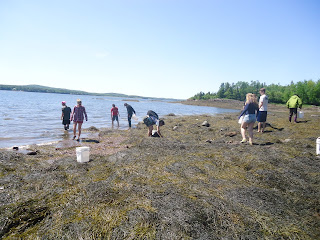On Tuesday the students conducted an experiment to determine the effect of temperature on the feeding rate of barnacles. The temperatures ranged from 5 to 25 degrees Celsius and the optimum did appear to be in the centre at around 15 degrees. They toured a part of the Huntsman called the
Atlantic Reference Centre (or ARC) which is a research museum for marine animals from the North Atlantic. A very cool place with aisles and aisles of preserved specimens, many of which are from the deep sea.
In the afternoon the group completed a right-side up experiment with sea star and urchins to see if size affects flipping rate. The smaller sea stars were faster. Between species, the sea stars were faster than the urchins.
The group also did the Almost Amazing Marine Race around the town of
St. Andrews, hitting stops such as Kingsbrae Garden, the Creative Playground, the Loyalist cemetery and the Algonquin Hotel.
Today the students helped us to gather data on an invasive species called the green crab. In an hour the students found 203 crabs!
Counting the cirri extensions of the barnacles.
Waiting for the temperature of the seawater to go up.
Barnacles in action.
Viper fish...look at those teeth!
Shrimp from the deep sea.
Flexible sea star.
Not so flexible sea urchin.
Gathering data on green crabs, an invasive species.
How many crabs do you see under this rock?
Once counted the crabs got a spot of nail polish.
























































